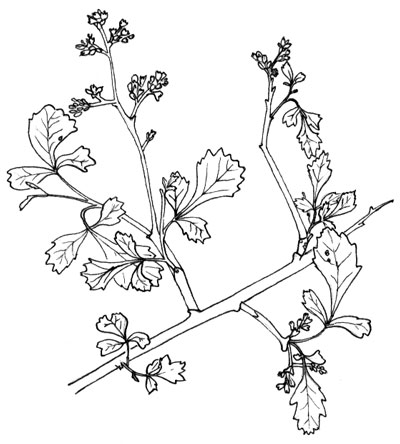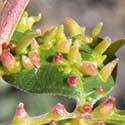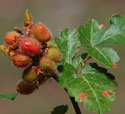Skunkbush Sumac
Rhus trilobata
(Rhus aromatica trilobata)

Drawn from live specimen found in Maricopa County, Arizona.
Sponsored Links:
The berries are eaten by birds and the leaves play host to a variety of insects and mites. The finger-shaped galls in the thumb-image below are caused by minute mites (arachnids) feeding and growing inside.
Skunkbush Gall-Mite

LEAVES: Compound leaves have three segments which have rounded lobes.
All the foliage will release pungent resinous terpenes on being crushed or
rubbed against. In autumn, like many sumacs, the deciduous leaves turn a
glorious orange-red. Few people get dermatitis from this plant.
SHRUB: A woody shrub usually. 1 to 3 meters
tall and often forming broad thickets.
RANGE: Skunkbush is a very common component of the understory in
sycamore canyons and can be found in most shady canyons in Arizona. It is also
found in the understory of the pinelands. Rhus aromatica of the eastern United States
is very similar save for slight differences in scent and the level of pubescence on the fruit.
Botanists have considered them conspecific.

FRUIT: Red berries with conspicuous trichomes
and a sticky texture.
FLOWERS: Whitish flowers are arrayed in compact
panicles blooming mostly in spring, sometimes before the leaves, but sporadically at other times
of the year.
UNARMED
Anacardiaceae -- Sumac Family
More Information:
- Southwest Environmental Information Network
- USDA Plants Database Profile
- Encyclopedia of Life
- Google Images
- Google Scholar Literature Search